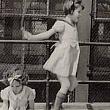
Little Girls' Clothing
by GRHC
published: December 1st, 2006
The invention and availability of the lock-stitch home sewing machine by 1843, the development of the paper-pattern business and manufactured clothing after the Civil War, and the increase of fashion publications all contributed to changing children’s fashion in the nineteenth and twentieth centuries. At the time children were posing for daguerreotypes their clothing would have been made either by a dressmaker or by their mothers. By 1872 the mail order business had been established and railroads crossed the country so items could be shipped anywhere. Mothers in Grand Rapids could order ready-made children's clothing from New York and dress their children in relatively up-to-date, fashionable clothing. If they owned a sewing machine they could purchase paper patterns for children's clothing that were just as up-to-date as ready-made garments. (Find more information to your right in Related Items)
Off-the-shoulder dresses for little girls were common in the 1840s and 1850s. Muslin, calico, and gingham were used for everyday, and silk, such as the child wears in this daguerreotype, would only be seen on children from well-to-do families. Her shoes with the laces up the ankle were typical of the 1850s as were short socks, but only on young children. In the 1830s waists were high in the empire style, but gradually worked their way down the body so that by the 1850s they were at the natural waistline. Often, colorful sashes were added to girls dresses.
Plaids became fashionable in the 1870s, and the complicated structure of this dress can easily be seen because of the plaid pattern. The use of tiers--from one to five--in the skirt was popular, and the neckline has moved off the shoulder to close around the neck. The dress may be two-piece which would allow for growth and longer wear. Her hair, pulled up at the sides with curls down the back, is also typical of the 1870s and 1880s. Boots, a common type of footwear, were often white or colored.
Starting in the late 1800s, illustrations in fashion catalogs usually indicated what was appropriate for girls of particular age groups, and skirt lengths were determined by age. By 1914 these two young girls wear cotton dresses with dropped waists and wide sashes. Long stockings are still worn by little girls with their "Mary Jane" shoes. The large hair ribbons were fashionable for girls for several years.
This class picture presents a glimpse of children's clothing in the 1920s. The dresses are loose fitting, straight, but without the sash common a few years earlier. One girl wears bloomers that show beneath the hem of her dress, a style sometimes seen in children's books depicting that time period. Gone are the high button shoes, but some girls still wear long stockings while others wear knee socks. Dutch bob hair styles appear on many of the girls in this class.
During the early 1900s hand-knit clothing for children became popular. It was still popular in the 1930s as this child's knitted snowsuit shows. Compared to modern water resistant fabrics that are easily laundered, this snowsuit would have become wet (and cold) and would need to be hand-washed. Other snowsuits consisted of a wool jacket and pants with zippers on the pantlegs. The heavy wool became uncomfortable when wet and took time to dry before it could be worn again. Mittens were knitted wool and often attached to strings that ran around the neck and down through the sleeves of the jacket.
Girls wore shorts and trousers for play by the 1940s, and sunsuits were popular in hot weather: but they sometimes still wore simple cotton dresses as this child does on a fishing expedition. Play dresses were usually cut on a simple, straight line and made of gingham or fabric with small prints. This was a time before drip-dry or no-iron fabrics so even play clothes had to be dampened and ironed.
Bibliography
Books available from the Grand Rapids Public Library
- Olian, JoAnne, Ed. Children's Fashions 1860-1912; 1,065 Costume Designs from "La Mode Illustree". New York: Dover Publications, Inc., 1994.
- Perry, Dame & Co. Women's and Children's Fashions of 1917. New York: Dover Publications, Inc., 1992.
- Sills, Leslie. From Rags to Riches; A History of Girls' Clothing in America. New York: Holiday House, 2005.
- Worrell, Estelle Ansley. Children's Costume in America 1607-1910. New York: Charles Scribner's Sons, 1980.

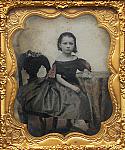


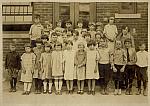
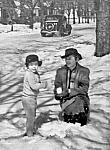
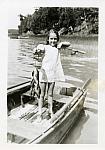
 facebook
facebook